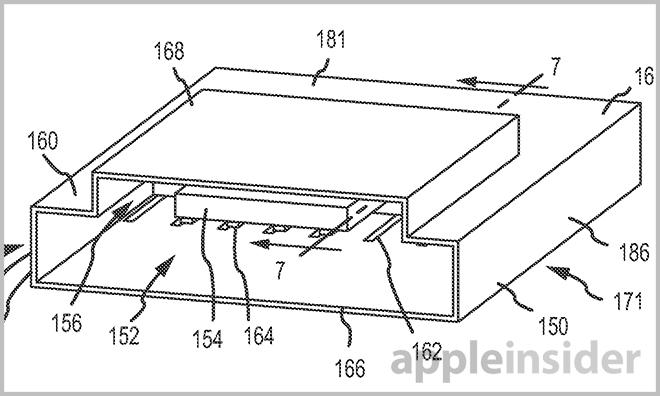A patent application discovered on Thursday shows Apple is actively looking for more ways to slim down its MacBook lineup, with the invention illustrating a combination SD card slot and USB port.
As published by the U.S. Patent and Trademark Office, Apple's "Combined input port" filing details a new system that integrates both an SD card reader and a USB port into one unit. The combination would not only save on external space, but also on the internal component layout needed to drive the two standards.
The invention's language is quick to point out that an SD card and USB port are merely illustrative, meaning the port could house any number of suitable interconnects, including the forthcoming Thunderbolt 2.
In its application, Apple uses the MacBook Air as an example device that would benefit from such an arrangement, though the setup could feasibly be implemented into any of the company's products.
In some embodiments, the input port may have electrical contacts located at different depths for the different connectors, e.g., a first set of contacts for the USB plug and a second set of contacts for the memory card. In this manner, the correct contacts may be aligned with the correct connector, even though both connectors may be inserted into the same port.Overhead view of contact depth.
Further, the invention calls for the port's aperture and enclosure to include physical attributes that facilitate secure connections when a cable is attached or a memory card is inserted. For example, alignment features like notches in a memory card can interact with retaining mechanisms like detents or springs disposed in the input port's walls.
As seen from the illustrations above and below, the single-port system is limited by the very idea that allows for the combination of two or more inputs. By varying the depth of the port's electrical connectors, the invention can support only certain types of hardware, though it is possible that the location of the contact surfaces be adjusted to conform to a given connector type.
Illustration of aperture.It is unclear if Apple plans to use the technology in an upcoming product, but similar products already exist as so-called "all-in-one" card readers. These external devices are not identical, however, as they don't deal with two completely different protocols as described in Apple's patent language.
Apple's combined input port patent application was first filed in 2011 and credits Changsoo Jang as its inventor.
 Mikey Campbell
Mikey Campbell




-xl-m.jpg)


-m.jpg)






 Amber Neely
Amber Neely
 William Gallagher
William Gallagher
 Malcolm Owen
Malcolm Owen

 Mike Wuerthele
Mike Wuerthele


 Thomas Sibilly
Thomas Sibilly








41 Comments
Okay Apple, so now fit them into your flipping phones and tablets, stop ripping us off with your gouging flash memory pricing structure.
So, uhm, what if I have a setup like now, with my SD card slot used regularly, and a cable connected to the USB port too?
So the next Mac book Air will be so thin that USB port will have to be integrated into SD slot ?
Okay Apple, so now fit them into your flipping phones and tablets, stop ripping us off with your gouging flash memory pricing structure.
hell, let's make them user installable. I want Android on my iPhone!
buy Samdroid. you can stick whatever you want in it....
I doubt Apple's ever going to actually implement this. For one, from the drawings it looks actually a little bit thicker than a standard USB port, not thinner. For another, it'd make you lose the use of one USB port while an SD card is in use. Finally, Apple has always tried to make make port shapes and connectors very distinct from each other: each connector goes in only one kind of port, each port only accepts one kind of connector. (The combo headphone/mic port seems like an exception, but it actually makes things easier in a sense, because it makes it so you can no longer accidentally plug headphones into a mic port or a mic into a headphone port.) A port like this also adds to customer support complexity when trying to discuss which USB port is "special" if only one has the SD card slot built in to it (notice how Apple made sure when it added USB 2.0 and USB 3 that all of a Mac's ports were upgraded, not just one).
Most likely this was another one of those patents thought about as "interesting idea, let's patent it even if we never use it, to pad out patent portfolio and make sure we've got it in our back pocket if we ever do something else similar and someone else has patented this idea in the meantime."
Not like we haven't seen plenty of those before on AppleInsider.